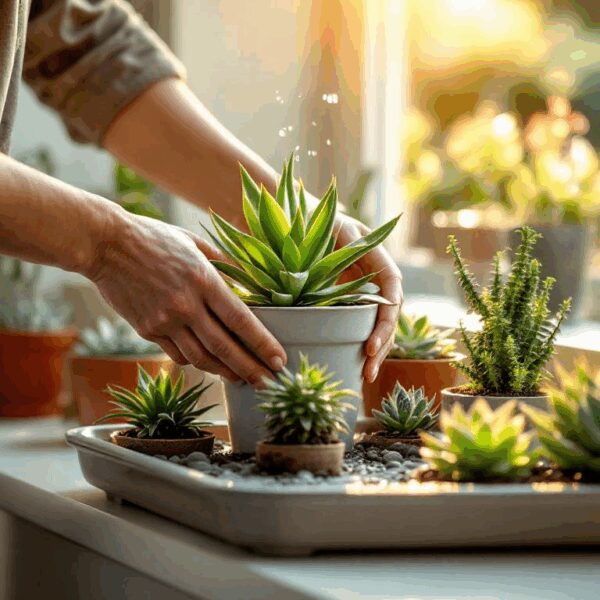If you’re searching for a houseplant that practically thrives on your forgetfulness, let me introduce you to the Snake Plant (Sansevieria). Seriously, it’s like your low-maintenance friend who doesn’t mind if you bail on dinner plans—just give it a spot in your home, and it’ll do its thing while adding a touch of beauty to your space.
🌱 Green Thumb Essentials in 4 Points:
- Watering Wisdom: Less is more! 💧 Snake Plants love to dry out completely between drinks. Water every 3-4 weeks in winter, and if the top inch of soil feels dry, it’s time for a sip. Overwatering? That’s a no-go!
- Light Love: Find that sweet spot! ☀️ These plants can handle low light but adore bright, indirect sunshine. Just avoid harsh direct rays—nobody likes scorched leaves!
- Temperature Talk: Keep it cozy! 🌡️ Aim for a home temp between 60°F to 80°F. They can withstand cooler temps, but steer clear of drafts—your Snake Plant will thank you for that cozy corner away from chilly winds.
- Pest Patrol: Stay vigilant but chill! 🐞 If those pesky mealybugs or spider mites show up, just wipe down the leaves with a damp cloth or use insecticidal soap. Regular checks can prevent a bigger headache later on.
Meet the Snake Plant: Your New Best Friend
As we transition into November, the air gets crisper, and indoor gardening becomes even more appealing. If you’re looking for a houseplant that truly thrives on neglect, look no further than the Snake Plant (Sansevieria). This plant is a champion of resilience, perfect for busy folks or anyone who might not have a green thumb.
Watering Wisdom: Less is More
First things first—let’s talk watering. Snake Plants are succulents, which means they store water in their leaves. They prefer to dry out completely between waterings. In fact, overwatering is the quickest way to kill this beauty. During the fall and winter months, when growth slows down, you really only need to water about every 3-4 weeks. Just stick your finger in the soil; if it feels dry an inch deep, it’s time for a drink.
Light Love: Finding the Perfect Spot
Now, onto light conditions. Snake Plants are incredibly adaptable. They can thrive in low light conditions but will flourish with bright, indirect sunlight. Just be careful—direct sunlight can scorch their leaves. As daylight fades in November, consider placing your Snake Plant near a window that gets filtered light, like one with sheer curtains.
The Humidity Mistake That Kills Tropical Plants When the Heating Turns On
Temperature Talk: Keeping It Cozy
This plant doesn’t like extremes. Ideally, keep your home between 60°F to 80°F. And while they can tolerate cooler temps down to 50°F, you’ll want to avoid drafts from windows or doors as winter approaches. So if you’ve got a cozy corner away from chilly breezes, that’s where your Snake Plant should go.
Feeding Finesse: A Little Goes a Long Way
Fertilizing isn’t necessary for Snake Plants, but if you feel inclined to give it a boost during the growing season (spring and summer), use a balanced houseplant fertilizer like Miracle-Gro at half strength once a month. Since it’s now fall and winter is knocking on the door, hold off on feeding until spring rolls back around.
Pest Patrol: Stay Vigilant But Chill
If pests do show up—think mealybugs or spider mites—don’t panic! A simple solution is to wipe the leaves with a damp cloth or spray them with insecticidal soap from Home Depot or Lowe’s. Remember, a little prevention goes a long way. Regularly check your plant; catching bugs early means less hassle later.
Repotting Realities: When and How
Snake Plants grow slowly and don’t need frequent repotting—about every 2-3 years should do it. If you notice roots poking through drainage holes or outgrowing their pot (which can happen if you’re using an oversized container), it might be time to bump them up to a slightly larger pot. Choose one that’s just 1-2 inches wider than the current pot; too much space can lead to overwatering issues.
Propagation Party: Share the Love!
If you’re feeling adventurous and want to propagate your Snake Plant, it’s super easy! You can do this through leaf cuttings or by dividing the rhizomes when repotting. Just cut a healthy leaf into sections (about 4-6 inches long) and let them callous over for a day before planting them in soil. Water lightly until you see new growth—what’s better than sharing your love of plants?
A Friendly Reminder: Pet Safety Matters
If you have furry friends at home, keep in mind that Snake Plants are mildly toxic to pets if ingested. It’s not likely they’ll take a bite since they tend to avoid plants anyway, but just keep an eye out if you’re introducing any new greenery into your home.
This November as we settle into cooler evenings and cozy indoor spaces, let your Snake Plant thrive on neglect while adding character to your home. With these care tips in hand, you’ll be well on your way to enjoying this unkillable houseplant all season long!







